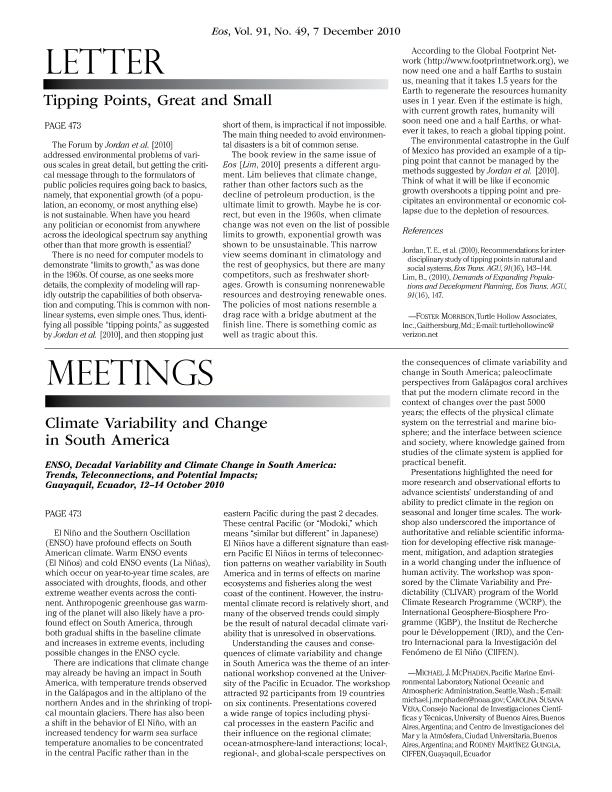Mostrar el registro sencillo del ítem
dc.contributor.author
McPhaden, Michael J.

dc.contributor.author
Vera, Carolina Susana

dc.contributor.author
Martinez Guingla, Rodney

dc.date.available
2017-06-02T17:46:23Z
dc.date.issued
2010-12
dc.identifier.citation
McPhaden, Michael J.; Vera, Carolina Susana; Martinez Guingla, Rodney; Climate Variability and Change in South America: ENSO, Decadal Variability and Climate Change in South America: Trends, Teleconnections, and Potential Impacts; Guayaquil, Ecuador, 12-14 October 2010; Wiley; Eos Transactions - American Geophysical Union; 91; 49; 12-2010; 473
dc.identifier.issn
0096-3941
dc.identifier.uri
http://hdl.handle.net/11336/17375
dc.description.abstract
El Niño and the Southern Oscillation (ENSO) have profound effects on South American climate. Warm ENSO events (El Niños) and cold ENSO events (La Niñas), which occur on year-to-year time scales, are associated with droughts, floods, and other extreme weather events across the continent. Anthropogenic greenhouse gas warming of the planet will also likely have a profound effect on South America, through both gradual shifts in the baseline climate and increases in extreme events, including possible changes in the ENSO cycle. There are indications that climate change may already be having an impact in South America, with temperature trends observed in the Galápagos and in the altiplano of the northern Andes and in the shrinking of tropical mountain glaciers. There has also been a shift in the behavior of El Niño, with an increased tendency for warm sea surface temperature anomalies to be concentrated in the central Pacific rather than in the eastern Pacific during the past 2 decades. These central Pacific (or “Modoki,” which means “similar but different” in Japanese) El Niños have a different signature than eastern Pacific El Niños in terms of teleconnection patterns on weather variability in South America and in terms of effects on marine ecosystems and fisheries along the west coast of the continent. However, the instrumental climate record is relatively short, and many of the observed trends could simply be the result of natural decadal climate variability that is unresolved in observations.
dc.format
application/pdf
dc.language.iso
eng
dc.publisher
Wiley

dc.rights
info:eu-repo/semantics/openAccess
dc.rights.uri
https://creativecommons.org/licenses/by-nc-sa/2.5/ar/
dc.subject
Climate Variability
dc.subject
Climate Change
dc.subject
Enso
dc.subject.classification
Meteorología y Ciencias Atmosféricas

dc.subject.classification
Ciencias de la Tierra y relacionadas con el Medio Ambiente

dc.subject.classification
CIENCIAS NATURALES Y EXACTAS

dc.title
Climate Variability and Change in South America: ENSO, Decadal Variability and Climate Change in South America: Trends, Teleconnections, and Potential Impacts; Guayaquil, Ecuador, 12-14 October 2010
dc.type
info:eu-repo/semantics/article
dc.type
info:ar-repo/semantics/artículo
dc.type
info:eu-repo/semantics/publishedVersion
dc.date.updated
2017-05-31T19:44:17Z
dc.journal.volume
91
dc.journal.number
49
dc.journal.pagination
473
dc.journal.pais
Estados Unidos

dc.journal.ciudad
Hoboken
dc.description.fil
Fil: McPhaden, Michael J.. National Ocean And Atmospheric Administration; Estados Unidos
dc.description.fil
Fil: Vera, Carolina Susana. Consejo Nacional de Investigaciones Científicas y Técnicas. Oficina de Coordinación Administrativa Ciudad Universitaria. Centro de Investigaciones del Mar y la Atmosfera. Universidad de Buenos Aires. Facultad de Ciencias Exactas y Naturales. Centro de Investigaciones del Mar y la Atmosfera; Argentina
dc.description.fil
Fil: Martinez Guingla, Rodney. Centro Internacional para la Investigación del fenómeno de El Niño; Ecuador
dc.journal.title
Eos Transactions - American Geophysical Union

dc.relation.alternativeid
info:eu-repo/semantics/altIdentifier/doi/http://dx.doi.org/10.1029/2010EO490006
dc.relation.alternativeid
info:eu-repo/semantics/altIdentifier/url/http://onlinelibrary.wiley.com/doi/10.1029/2010EO490006/abstract
Archivos asociados
